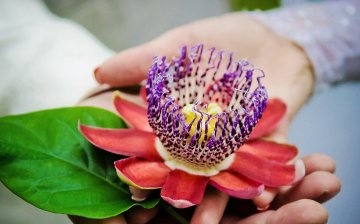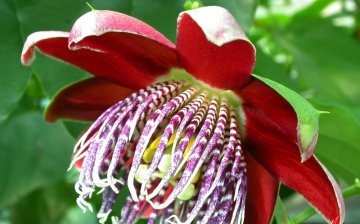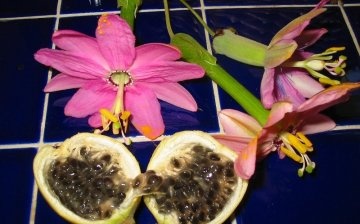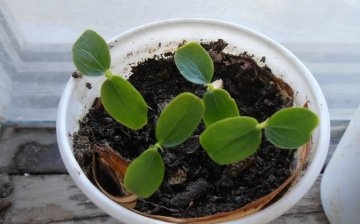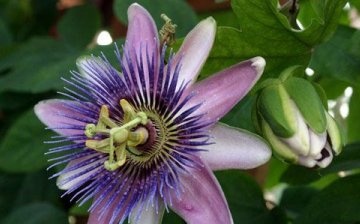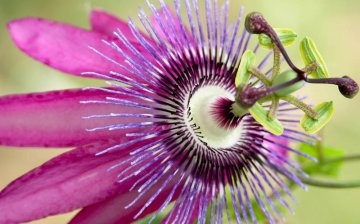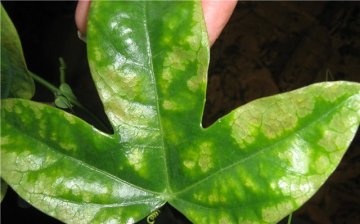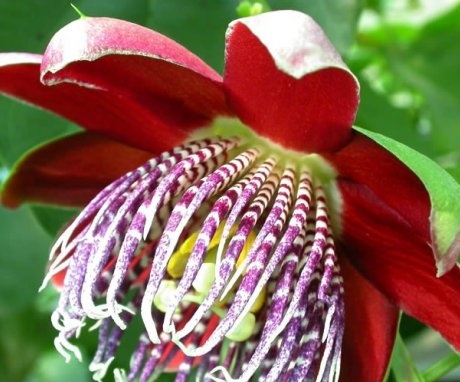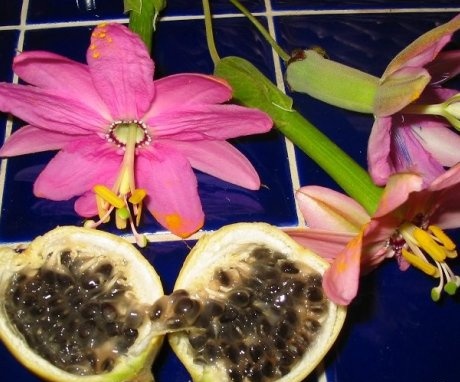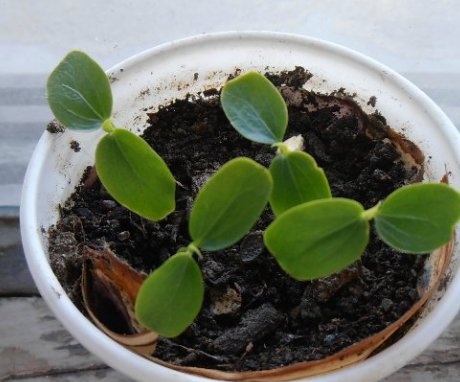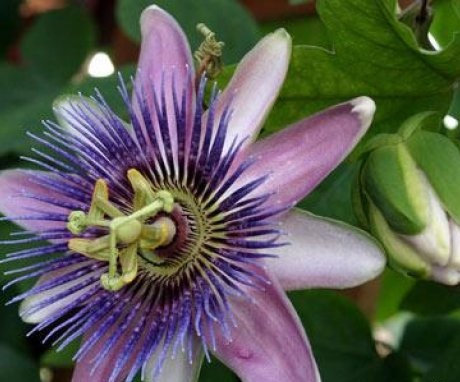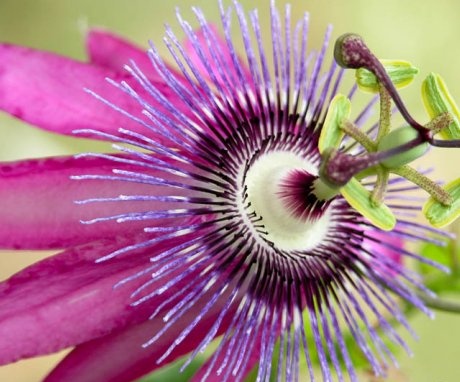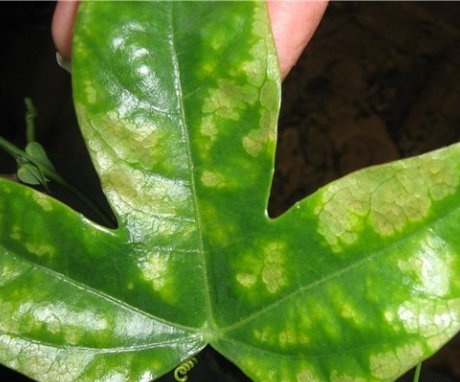Passionflower from seeds: soil preparation, planting seeds and proper care
Passionflower - a beautiful exotic plant with large flowers, similar to the order of the "Cavalier's Star" (the plant is often called that). Another name for passionflower is passion flower. Widely known for its amazingly beautiful flowers, the plant also has medicinal properties and yields delicious fruits such as the well-known passion fruit.
Content:
- Description of the plant
- Seed and soil preparation
- Planting seeds
- Care after landing
- Diseases and pests
Description of the plant
Passionflower - evergreen liana from the passionflower family. In the wild, passionflower is found in Brazil, Peru, tropical regions of Asia and Australia.
Usually passionflower reaches a length of 10 meters, but there are plants up to 45 meters long. With the help of antennae, the vine clings to a support (for example, a tree) and climbs up. Leaves of an unusual two-color color: the lower plate is gray, the upper one is green.
Passionflower flowers, very unusual and unlike any other flowers in the world, come in white, purple and red shades.
Unfortunately, passionflower does not bloom for long. Inside the star-shaped bright perianth, there are long straight or curved staminodes (modified stamens without anthers), similar to filaments, in the center there is an ovary with three stigmas located crosswise and five anthers.
Fruits are round, egg-shaped, orange or bluish in color, can reach 6 cm in length, are considered edible. To obtain fruit when growing passionflower at home, it will have to be manually pollinated. Given that the plant is cross-pollinated, you need to have two or three types of passionflower. Thus, you can get fruits and, accordingly, seed.
One of the unusual properties of passionflower is the ability to accumulate poisonous substances in the leaves, which serve as protection for the plant from pests.
It is important to know that any part of the plant, with the exception of the fruit, can cause hallucinations and paralysis. Therefore, all work with passionflower must be carried out with gloves, especially pruning... Passionflower is considered a medicinal plant. The leaves, stems and roots of the plant are used in the treatment of the respiratory and nervous systems. Some types are used in sedatives, anthelmintics, tonic, pain relievers. May increase blood pressure. But medicines from passionflower cannot be consumed by people suffering from cardiovascular diseases and sclerosis.
The most popular types:
Seed and soil preparation
By choosing the seeds passionflower in specialized stores, pay attention to the date of packaging. The germination period of old seeds can take up to a year. Although, as practice shows, freshly harvested seeds do not necessarily sprout quickly. The germination period of seeds is determined by the type of passion flower: in some species, seeds germinate in 2 weeks, in others - from 3 to 5 months or even a year. Naturally, it is very difficult to maintain the same conditions when germination a few months.
Therefore, before planting seeds, it is better to carry out the scarification procedure.
The day before planting, it is recommended to soak the scarified seeds in freshly squeezed lemon or orange juice. In easily grown passiflora species, the seeds can not be scarified and processed only with "Kornevin".
Passion flower seeds are planted in peat tablets or in specially prepared soil. To do this, take in equal parts:
- Peat
- Sand
- Humus
- Leafy ground
Self-prepared soil must be disinfected: sprinkle on a baking sheet with a layer of 1 cm and heat in the oven at 200 degrees for 10-20 minutes. You can buy soil from the store and add sand to it.
Planting seeds
Seeds are planted in February in separate containers to a depth of 1-2 centimeters. The containers are covered with polyethylene and placed in a room with a temperature of 25 ° C. Every day, the containers must be ventilated for 5 minutes, spray soil as needed.
After the emergence of seedlings, the plants are rearranged in a lighted place.
You can germinate passionflower seeds in advance of planting:
- Prepare or buy distilled water.
- Put the seeds in a container with water for a day.
- Remove the seeds that have emerged after a day.
- Put the remaining seeds in a small amount of 3% hydrogen peroxide (in this case, it should burst).
- Pour 100 ml of water into a glass container, add 50 drops of hydrogen peroxide.
- Put the seed material in the resulting solution.
- Cover the container and place in a dark, warm place for 7-14 days.
- Do not open until seeds have germinated.
- Sprouted seeds are removed with tweezers (previously disinfected) and planted in peat tablets or prepared soil.
- The remaining seed is again poured with the solution until germination.
Another way to reduce sprouting time is to use temperature differences:
- Cover containers with planted seeds with foil.
- Put in a well-lit place where a difference between day (28-30 degrees) and night temperatures (about 10 degrees) will be ensured, for example, a balcony or loggia.
- Passionflower of any kind necessarily rises within 2 months.
- Remove the film after emergence.
When planting seeds in any way, shoots after the appearance of two true leaves dive (transplanted) in a container with a diameter of 7 cm. At the bottom of the containers, it is imperative to lay drainage, which must be at least a quarter of the volume of the container itself. It should be noted that it is better to propagate passionflower at home. cuttings, since caring for them is much easier than for seedlings.
Care after landing
Passionflower is a tropical plant that accordingly requires a lot of light and moisture. Passionflower will grow best in direct sunlight, but indoor plants should be lightly shaded at midday to avoid leaf burns. With a lack of light, you can not wait for flowering, or it will be very scarce.
In the southern regions, passionflower can be grown outdoors. With good ventilation, the plant can tolerate temperatures up to +40 degrees. But this will still be considered overheating.
Watering a flower:
- Caring for the plant consists in regular abundant watering and spraying (in summer). The soil should be constantly moist (not waterlogged).
- It is important to remember that excess moisture contributes to root rot. Since autumn watering cut, while the soil should not dry out.
- For irrigation, use settled water at room temperature. You can add a little citric or acetic acid to the water to soften so that the sourness does not taste. It is recommended to drain the water from the pallet on which the container with the plant stands.
- In the summertime, passionflower is recommended spray twice a day, preferably with boiled or filtered water.Once a week, you can do a warm shower for the plant, which will clean the leaves of dust and serve as a prevention from pests... Spraying is not necessary in winter.
In winter, in a room with passion flowers, you need to maintain an air temperature of at least 13 degrees, in summer - about 24 degrees. At hotter temperatures, few buds are formed, and the castings turn yellow and fall off. It is recommended to ventilate the room periodically.
During the growing season, two or three complex fertilizing will be enough mineral fertilizers for flowering plants.
In winter, feeding is not necessary. In the first year of growth of passionflower, it is important to provide support, since it is during this period that the plant forms the main shoots. Otherwise, the main shoots will stop developing, and only lateral ones will grow. Attach 2 or three central shoots to the support, and cut the rest by a third each year. For flowering passionflower not only should have a lot of light and moisture: flower buds arise on annual shoots, therefore, already in the second year of life, the plant is recommended prune one third or even half the length of the shoots. Pruning will promote active shoots and, consequently, new buds to set.
Pruning is carried out in the spring, before the plant begins to grow. All shoots of the previous year are cut off, leaving two or three buds at the base. If a curved wire was used to support the passionflower and it is difficult to find the beginning of the stems, you can pinch the tips of the shoots instead of pruning. This will also stimulate lateral branching.
If the passionflower grown from seeds does not bloom in any way, you can try propagation by cuttings:
- Choose lignified shoots with two nodes and leaves.
- Cutting down.
- Place in a jar with water.
- Add charcoal (one piece is enough).
- The water will evaporate and must be topped up.
- After one or two months, roots will appear (the water cannot be changed).
- Plant in soil.
- After a year, the plant should bloom.
Young passionflower plants are recommended transplant every spring, adults - every three to four years. A transplant is needed to remove dead roots and renew the soil. The containers should be of a larger diameter than the previous ones, but not by much. Too large a transplant capacity favors the active development of the root system and the green mass of passionflower to the detriment of flowering.
For an adult plant, the maximum diameter of the container should not exceed 30 centimeters.
Before transplanting, the shoots of passionflower are cut by a third. In the first month after transplanting, the plant should be watered moderately, subsequently watering increase.
Diseases and pests
Although passionflower, producing toxic substances, itself knows how to defend itself from pests, there are still cases of attack by harmful insects.
- Spider mites often attack passiflora. A sign of the appearance of a pest is excessive dropping of leaves and a change in their color to a paler one. If the mite appears on small plants, it can be removed by rinsing the foliage several times with a warm shower. Large passion flowers are processed drugs "Actellik" or "Fitoferm".
- Nematodes are another pestharmful to passionflower: microscopic worms have a detrimental effect on all parts of the plant, changing their structure. Often, nematodes can be detected too late, when the plant is already dying. To avoid infection with nematodes, it is imperative: disinfect the soil, use high-quality seeds, spray the plants only in dry warm weather, the diseased plant will have to be destroyed.
In winter, with excessive moisture, passionflower can be affected by fungal diseases.
As a preventive measure, it is necessary to prevent waterlogging of the soil during the cold period; any fungicides can be used to combat fungal diseases.
Many diseases of passionflower are caused by improper care of it:
- Lack of light, nutrition or heat, excess nitrogen in the soil leads to a lack of flowering or its scarcity.
- Waterlogging of the soil causes root rot.
- Low temperatures have a bad effect on the leaves: they curl and become soft.
- Dry air causes buds to fall off.
When passionflower decays due to excessive moisture, the plant needs transplantremoving diseased roots. If the decay process has spread to the trunk of the plant, then it can only be saved cuttings.
More information can be found in the video.



